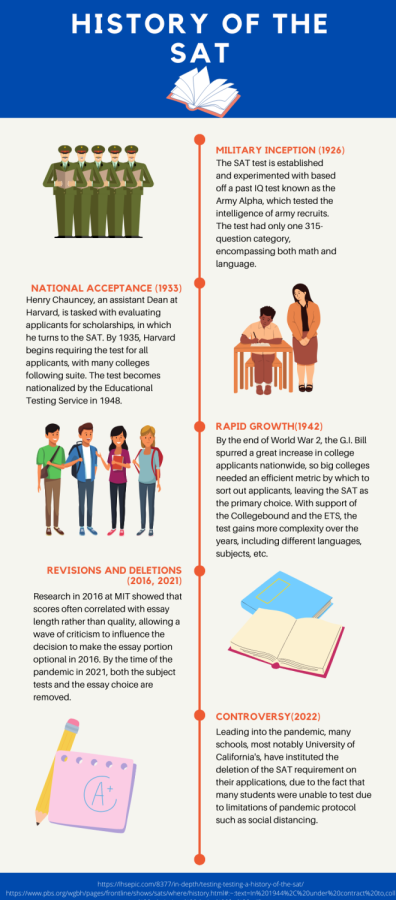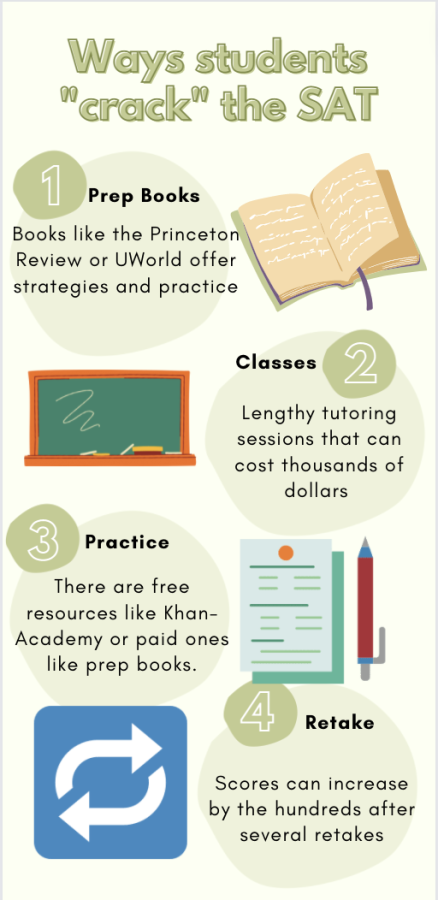Face-off: Should the SAT be reinstalled as a factor in college admissions?
May 5, 2022
The SAT, the three-hour-long standardized exam, is supposed to measure students’ abilities. However, some argue that the SAT does not properly do its job.
Yes: SAT should be a required part of college admissions
Since the 1950s, the SAT has been normalized as one of the primary aspects of college admission for all students across America. With the deletion of the SAT requirement in the college admissions process for UCs just around two years ago, the formal reinstatement of the SAT requirement at MIT, and finally the planned change of the SAT in 2024, it is clear that the SAT isn’t without great controversy.
However, despite continuous changes, the SAT and other national exams should continue to return to dictate admissions in US colleges.
The prime purpose of national exams such as the SAT is simple: maintaining a national standard for all American students. With such an extensive amount of financial and ethnic diversity in America, students are educated in a range of environments, with some schools offering higher or lower levels of quality education than others.
Therefore, with a basically unchanged curriculum that is tested on a national level, colleges can use the SAT score to properly gauge a student’s capabilities regardless of their educational environment.
“I think the biggest problem college admissions officers face is that there they are not able to get a full profile of the student because so much of the student’s grades are very school dependent, and somebody’s perceived excellent largely depends on the teachers they have and how hard the classes are in general, so that’s where the SAT comes in,” said Aryaditya Lankipalle(‘23).
Leading opposition to the SAT is often based on the argument that it is unfair. While it can be said that the SAT discriminates against students of different ethnic and social classes, who may lack privilege, this is actually quite the opposite. Credible sources have demonstrated that universal testing such as the SAT is actually beneficial to gifted students who only lack opportunity, and also are a great indicator of college success.
Removal of the SAT doesn’t translate to the end of wealthy families dominating college admissions. These families can instead direct their money toward affording high-quality extracurriculars such as pristine unpaid internships or guided research. In this work, having the SAT as a benchmark for all students, rich or poor, helps eliminate this inequity.
Getting rid of a historically reliable means of prospecting college admission has another obvious detriment: admission becomes more dependent on grades and extracurriculars. As a result, students who specifically struggled in a classroom and point-based environment have no other means of showing colleges how far they have come and improved.
“For students that have previously hoped to gain some [academic recognition] through test scores, especially if they were concerned that their grades did not represent their proficiency, this may no longer be an option,” said AV College and Career Counselor Lara Bays.
Overall, the SAT offers a great opportunity for all students to demonstrate their academic competence at a national standard, and even gives students of impoverished backgrounds the best possible chance for admission into the best colleges.
No: Test-optional policies should stand
There are plenty of ways to score well on the SAT, most of which require extra money and resources.
Ever since the SAT was introduced in 1926, colleges have used it to determine students’ academic ability. In recent years, the importance of the test is waning and most colleges have gone test-optional or test blind. However, MIT recently announced its decision to reinstate the SAT requirement, an example that other colleges can follow. However, test-optional policies should stay.
The SAT has an awful reputation among high school students: its length is 3 hours, during which students have to maintain their focus to score well. The problems are boring and tedious – typical of that of a standardized test.
“I took [the SAT] at Amador, during the COVID year. Even when I had friends in the room, it was still a terrible experience. I don’t think anyone would perform well when you are stuck in a seat for multiple hours,” says Arthur Hua (‘22).
To do well on the test, most students have to take several practice tests as preparation. The practice is as painful as the real test: a student has to take a large chunk of their day and exhaust themselves, only to do it again if they are not confident in their performance.
“I wanted to [figuratively] die every single time I had to take [the SAT], ”said Sarah Zhang (‘23), who took the SAT last year.
The predictable format and topics of the SAT led to the rise of an entire industry of preparation, including tutoring classes and prep books.
“My parents didn’t trust me to take the SAT by myself, so they made me take a course and spent a bunch of money,” said Zhang.
With these resources and enough practice tests, most students can achieve their goal score. In addition, unsatisfied students can retake the test, and the average student who retakes the SAT receives a score boost of more than 100 points.
The thriving SAT preparation industry shows its success, thus how the SAT is coachable. The test measures how well a student can prepare for it, which admittedly can tie into work ethic, but not their overall intelligence or worth, because with the right resources and time, the SAT is doable for most students.
These resources also require immense amounts of money and extra time, which is why the SAT discriminates against low-income students whose families cannot afford summer tutoring sessions for thousands of dollars.
Test-optional admissions change everything — students are evaluated less on the number of resources they have to prepare for a test and more on everything else on their application.
“I think the [test optional policy] definitely saved me. When you remove a standardized test, you are forced to spend more energy assessing a student’s extracurriculars and reading through his essay. The SAT optional policy got me into the college I committed to, ” said Hua.

